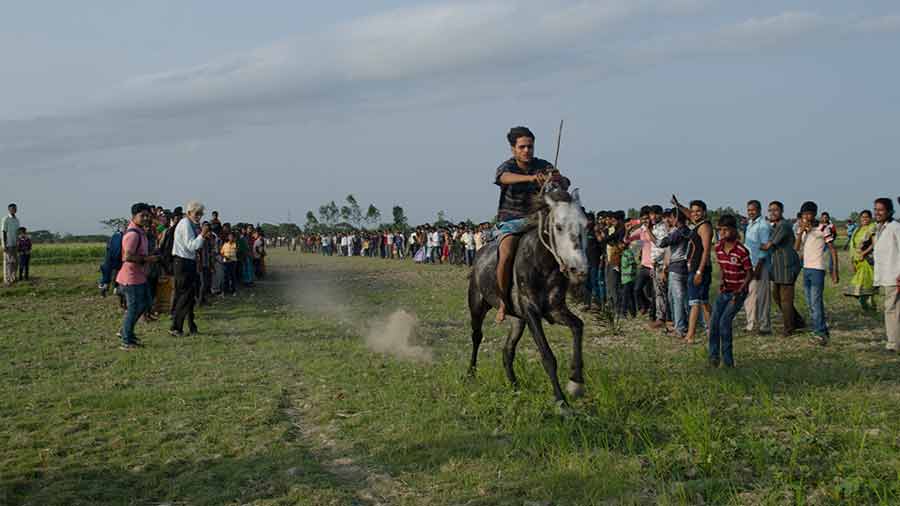The fastest participant wins the race; winners of league races qualify for the semi-finals, followed by the grand finale. Sounds like any sporting competition? But there are a few surprises in store: the prize is not a trophy or a medal, but a cupboard or a cycle or utensils. And, hold your breath, the participants are not humans, but bulls!
The bull race or Moi Chara is a centuries-old tradition still popular in the villages of the South 24 Parganas.
My Kolkata visited Herobhanga village, the venue of the biggest races, to witness the excitement.
The ritual of a sport
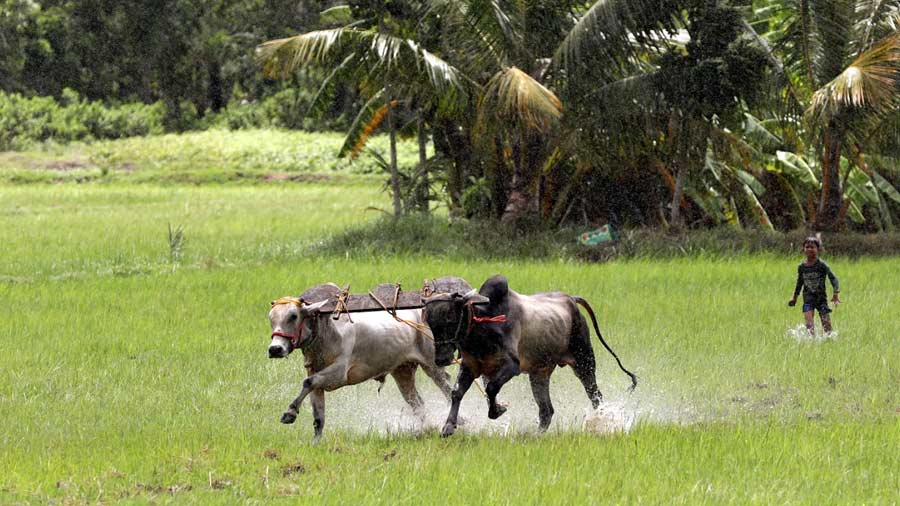
Bulls attached to a wooden frame or a ‘moi’ Photos: Arijit Sen
Two bulls or cows are first attached to a wooden frame or a moi — that is how the race gets its name. Two such pairs compete against each other in a race. Each pair is controlled by a jowal dhora or trainer.
Any pair that goes out of the boundary of the track is eliminated. Else, whichever pair reach the finishing line first win.
“The winners of the league matches compete in semi-finals and then the final to win the ashor (tournament) and the prizes include a cupboard, cycle and utensils,” said Tarikul Islam, whose family has been organising the cattle races at Herobhanga village for the past 29 years.
Run-up to the race

The racing cattle are not used for farming
The cattle that participate in the races are not used for farming or any other purpose. They are taken care of all through the year and the owners invest in the animals to the best of their ability.
“The cows and bulls are given a special diet that includes seasonal fruits and jaggery. They also receive regular training and exercises. It costs around Rs 4,000 a month to maintain a racing bull,” said Sushanta Bain, a trainer.
“The animals are bought from different markets in Gopalgunge, Kaikhali, Jalaberia, Raghunathpur and even from Odisha and can cost anything from Rs 50,000 to Rs 1 lakh,” said Rejaul Karim Laskar, owner of two participating bulls. “If the animal has already won a race, then its price in the market can go up three-fold or four-fold.”
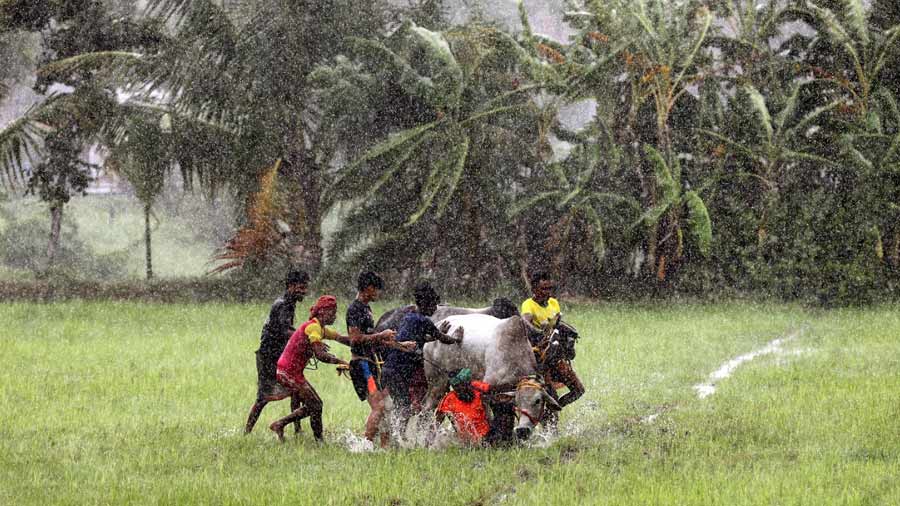
Moi Chara is held in the monsoon. It is also a way to welcome the rains for the villagers
The field, or the track for the race, too, needs to be filled with water and that is why Moi Chara is held in the monsoon. It is also a way to welcome the rains for the villagers.
Moi Chara and its social aspect
Winning a tournament not only means the cows will have a greater economic value and can be sold at a big price if desired, but also gives the owners a more respectable place in the village hierarchy.
Soeb Ali Molla, the most experienced trainer in the locality, said Moi Chara has become more like the derby races in Kolkata. Earlier, the same cows that were used for ploughing fields would also take part in Moi Chara but now the practice has changed. Just like horses bred for derby races are not used for any other purpose, cows that participate in Moi Chara are also not used for any other work.
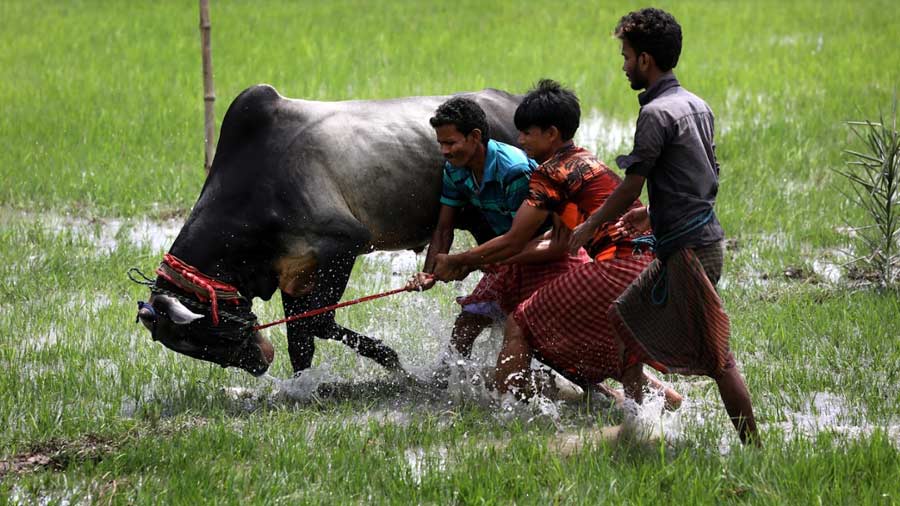
Just like racehorses, cows that participate in Moi Chara are also not used for any other work
“Many of us earn money throughout the year because of this. I have been training cows for the last 42 years,” he said. Now, Molla works for a cattle owner, training and breeding two cows. “I earn Rs 20,000 per year from this besides my other income,” he said.
Roots in ancient culture and mythology
Moi Chara first began in the north-eastern states more than 3,000 years ago, according to Debi Sankar Midya, a local historian of the Sunderbans who runs a museum. “From there, it spread to different parts of Bengal. Even today, you see similar traditions like Badna Parab among Mahali, Munda and other tribes. The only difference is they use buffaloes, while in Moi Chara mostly cows and bulls are used,” he said.
The story, according to Midya, goes that Shiva once got into an argument with Parvati. He came to stay in Bengal and decided to take on farming. “But Shiva needed a plough, so he made it out of his trident. Soon, he had a disciple named Bhim (not from the Mahabharat) and together the two ploughed land together,” Midya narrated. One day, just before the monsoon, Shiva and Bhim struck upon the idea of a cattle race to decide which bulls were the strongest. “That is how Moi Chara began, it is believed,” he said.
Time for festivities
The tradition has now gone beyond the barriers of religion as both Hindu and Muslim villagers take part with equal enthusiasm.
Moi Chara is not just a cattle race but it is also a time to celebrate. For two days, the village goes into festive mood. People from the cities visit, too.
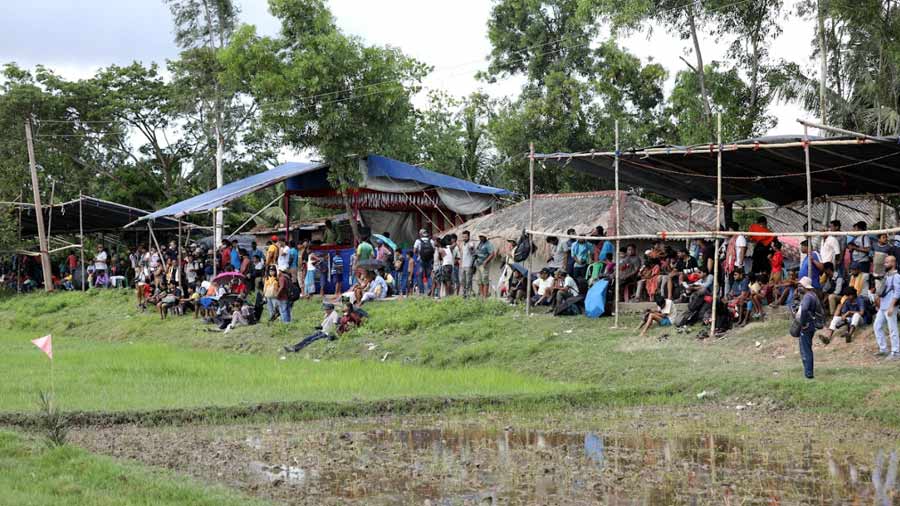
Visitors at the venue
“This is like a local festival. People from nearby villages come to see the races, while many others come to see the big cars, cameras and drones brought in by the tourists,” Tarikul said.
At a fair, where everything from food to cheap toys is sold, the young and the old throng the stalls. Local villagers sell fresh fruits like guava, green mango and star fruit. Jhalmuri, alu kabli, kulfi and lemon juice are popular items.

Part of the small fair
Moi Chara and its economic impact
Nakuleswar Mahato, a farmer in Canning, was in two minds when a documentary filmmaker from Kolkata, Sumanta Bhattacharjee, requested him to let him stay at his home for two days. He was documenting the Moi Chara ritual at Herobhanga village and needed a nearby place to stay.
Mahato didn’t want to turn away a guest but knew he just did not have the means to feed an extra mouth even for a few days. So, when Bhattacharjee offered to pay for the stay, after much deliberation, Mahato accepted the offer.
“I arranged for an extra bed and food for the guest. Later, they told me this system is called homestay and I could earn money by letting out my home to travellers. Maybe if someone approaches me next time, I could also make some money by providing accommodation and food,” Mahato said.
With more and more people from the cities visiting Herobhanga and its nearby villages during Moi Chara, a lot of economic activities have begun.

In Herobhanga and its nearby villages, a lot of economic activities are centred around Moi Chara
As people from the cities visiting Herobhanga and its nearby villages during Moi Chara, the fair has turned into an income generator for the villagers. Local hotels have also started getting some guests from the city during this time. Auto and toto drivers ferrying tourists make some extra money on the two days of Moi Chara.
Sharmishtha Basak, a dentist from Kolkata, was at Herobhanga with her family to witness Moi Chara. “It’s just a couple of hours by road from Kolkata and there are several beautiful spots nearby like the Piyali river. The only problem is the lack of accommodation. The concept of homestay, too, is new here. More people will come if things are more organised here,” she said.
The pandemic effect
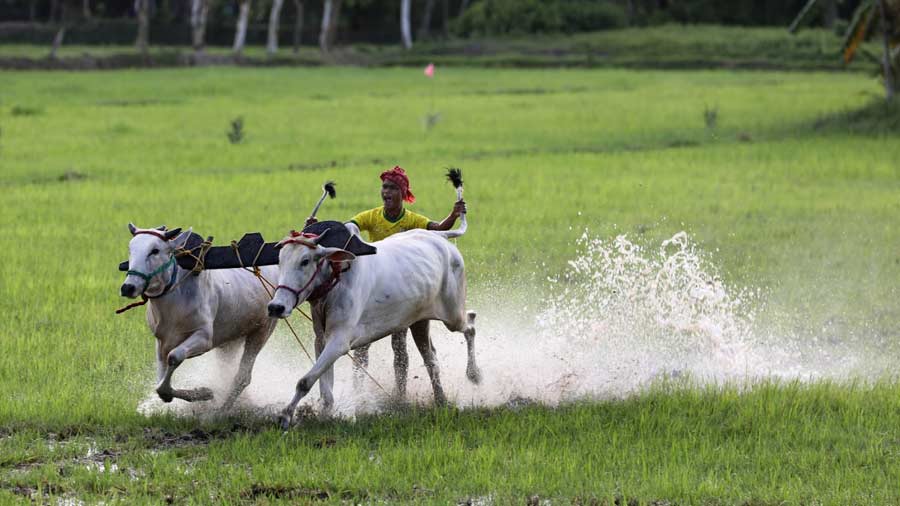
The pandemic suspended the tournament for two years
The pandemic dealt its blow and the Moi Chara tournament could not be held for two years. Many of the champion cows have aged and are no longer fit for the race.
“A cow needs to be trained from the age of three and can run only up to a certain age. Two years gone is a lot for the owner,” said Soeb.
The inconsistent monsoon has been another challenge. Ideally, the farming land needs to have eight to 10 inches of rainwater for the race. “This year, there has been no rain and we have pumped water from a nearby water body to create the court. This might not be possible every year,” Tarikul said.
The prayer on the lips of villagers is that they can carry on with the ancient tradition. Whether their prayers will be answered, only time will tell.
